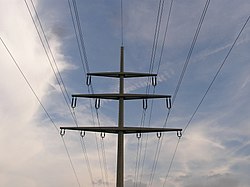Transmission tower

A transmission tower or pylon (also known as an ironman in Australia and a hydro tower in parts of Canada) is a tall tower used for electric power transmission. It carries the electrical conductors (wires) of high-voltage overhead power lines. The tower is high for a safe distance for people, animals or things below the wires.
Most big transmission towers are lattice steel structures. Smaller ones may be wood, concrete or steel poles.

Types
Most transmission towers are built as suspension towers. They only hold up the wires, not pull them. Their insulators are used vertically.
Tension towers (also known as anchor towers) pull on the wires. Their insulators are used horizontally. They work as terminal towers at the end of a power line. They work as branch towers where power lines split and run in different directions.
Transposition towers are relatively rare. They allow the wires to change their position on the tower.
Transmission Tower Media
HVDC distance tower near the Nelson River Bipole
Typical T-shaped 110 kV tower from the former GDR
Guyed "Delta" transmission tower (a combination of guyed "V" and "Y") in Nevada
Steel tube tower next to older lattice tower near Wagga Wagga, Australia
Related pages
| Wikimedia Commons has media related to Lua error in Module:Commons_link at line 62: attempt to index field 'wikibase' (a nil value).. |











